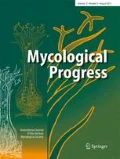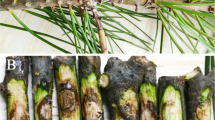Abstract
The ‘Poblano’ pepper crop is economically important in Mexico and throughout the world as it is used as a hot spice in food. The cultivated area of the ‘Poblano’ pepper crop is decreasing yearly for many reasons, among them a wilt disease commonly associated with Fusarium spp. This disease is a problem of field and greenhouse production plants. Moreover, it is not clear whether the pathogens that cause wilt in mature plants are the same as those involved in the damping-off symptoms and death of pepper seedlings in greenhouses. For this reason, the aim of the present study was to identify the causal agent of damping-off in pepper during seedling production, establish its relationship with the causal agent of wilting in mature plants, and determine whether histological damage in seedlings occurs. Isolates were recovered from the crown rot and stem base of 4-month-old infected ‘Poblano’ mature pepper plants and were identified using morphological and phylogenetic approaches. Fusarium oxysporum and F. solani were isolated from the crown rot and base stem, respectively. A pathogenicity test showed that both species caused damping-off in pepper seedlings. Histological studies with inoculated seedlings of both isolates showed several changes in the external cortex, epidermal cells, endodermis, Casparian strips, cell size, and xylem wall. Casparian strip rupture resulted in permeability loss and regulatory activity to maintain the cellular equilibrium inside the vascular bundles. Hence, according to these findings, producers should avoid seedling contamination by infected mature plants because the aggressiveness of Fusarium isolates can cause rapid seedling mortality.







Similar content being viewed by others
References
Altschul SF, Madden TL, Schaffer AA, Zhang J, Zhang Z, Miller W, Lipman DJ (1997) Gapped BLAST and PSIBLAST: a new generation of protein database search programs. Nucleic Acids Res 25(17):3389–3402
Beckman CH (1987) The nature of wilt diseases of plants. American Phytopathological Society Press, St Paul
Benson DA, Karsch-Mizrachi I, Clark K, Lipman DJ, Ostell J, Sayers EW (2012) GenBank. Nucleic Acids Res 40:48–53
Booth C (1971) The genus Fusarium. Commonwealth Mycological Institute. Kew, Surrey, England
Burgess LW, Summerell BA, Bullock S, Gott KP, Backhouse D (1994) Laboratory manual for Fusarium research. The University of Sydney and The Royal Botanic Gardens, Sydney, Australia
Chialva M, di Fossalunga AS, Daghino S, Ghignone S, Bagnaresi P, Chiapello M, Novero M, Spadaro D, Perotto S, Bonfante P (2018) Native soils with their microbiotas elicit a state of alert in tomato plants. New Phytol. https://doi.org/10.1111/nph.15014
Collmer A, Keen NT (1986) The role of pectic enzymes in plant pathogenesis. Annu Rev Phytopathol 24:383–409
Dale J, James A, Paul JY, Khanna H, Smith M, Peraza-Echeverria S, Garcia-Bastidas F, Kema G, Waterhouse P, Mengersen K, Harding R (2017) Transgenic Cavendish bananas with resistance to Fusarium wilt tropical race 4. Nat Commun 8(1):1496
Di Pietro A, Madrid MP, Caracuel Z, Delgado-Jarana J, Roncero MIG (2003) Fusarium oxysporum exploring the molecular arsenal of a vascular wilt fungus. Mol Plant Pathol 4(5):315–325
Doyle JJ, Doyle JL (1990) Isolation of plant DNA from fresh tissue. Focus 12(1):13–15
FAOSTAT (2015) Food and Agriculture Organization of the United Nations. Statistical, Agricultural Production. On-line [http://faostat.fao.org/site/342/default.aspx]. Accessed 10.02.2015
FAOSTAT (2017) Food and agriculture organization of the united nations. Statistical, agricultural production. On-line [http://wwwfaoorg/faostat/en/#data/QC] Accessed 08.02.2018
Fayzalla EA, Shabana YM, Mahmoud NS (2008) Effect of environmental conditions on wilting and root rot fungi pathogenic to solanaceous plants. Plant Pathol J 7(1):27–33
Ferniah RS, Daryono BS, Kasiamdari RS, Priyatmojo A (2014) Characterization and pathogenicity of Fusarium oxysporum as the causal agent of Fusarium wilt in chili (Capsicum annuum L.). Microbiology 8(3):121–126
Fisher NL, Burgess LW, Toussoun TA, Nelson PE (1982) Carnation leaves as a substrate and for preserving cultures of Fusarium species. Phytopathology 72:151–153
Geiser DM, Jimenez-Gasco MM, Kang S, Makalowska I, Veeraraghavan N, Ward TJ, Zheng N, Kuldau GA, O’Donnell K (2004) FUSARIUM-ID v.1.0: a DNA sequence database for identifying Fusarium. Eur J Plant Pathol 110(5):473–479
Geiser DM, Aoki T, Bacon CW, Baker SE, Bhattacharyya MK, Brandt ME, Brown DW, Burgess LW, Chulze S, Colemann JJ, Correll JC, Covert SF, Crous PW et al (2013) One fungus, one name: defining the genus Fusarium is a scientifically robust way that preserves longstanding use. Phytopathology 103(5):400–408
Genre A, Chabaud M, Faccio A, Barker DG, Bonfante P (2008) Prepenetration apparatus assembly precedes and predicts the colonization patterns of arbuscular mycorrhizal fungi within the root cortex of both Medicago truncatula and Daucus carota. Plant Cell 20:1407–1420
Goodman NR, Király Z, Wood KR (1986) The biochemistry and physiology of plant disease. University of Missouri Press, Columbia
Gordon TR (2017) Fusarium oxysporum and the Fusarium wilt syndrome. Annu Rev Phytophathol 55:23–39. https://doi.org/10.1146/annurev-phyto-080615-095919
Guadet J, Julien J, Lafay JF, Brygoo Y (1989) Phylogenetics of some Fusarium species, as determined by large-subunit rRNA sequence comparison. Mol Biol Evol 6(3):227–242
Hall TA (1999) BioEdit: a user-friendly biological sequence alignment editor and analysis program for Windows 95/98/NT. Nucleic Acids Symp Ser 41:95–98
Huelsenbeck JP, Ronquist F (2001) MRBAYES: Bayesian inference of phylogenetic trees. Bioinformatics 17(8):754–755
Iwahara S, Nishihira T, Jomori T, Kuwahara M, Higuchi T (1980) Enzymatic oxidation of α,β unsaturated alcohols in the side chains of lignin-related aromatic compounds. J Ferment Technol 58:183–188
Jones TM, Anderson AJ, Albersheim P (1972) Host-pathogen interactions IV. Studies on the polysaccharide degrading enzymes secreted by Fusarium oxysporum f. sp. lycopersici. Physiol Plant Pathol 2(2):153–166
Leslie JF, Summerell BA (2006) The Fusarium laboratory manual. Blackwell Publishing Professional, Ames
Lievens B, Rep M, Thomma BPHJ (2008) Recent developments in the molecular discrimination of formae speciales of Fusarium oxysporum. Pest Manag Sci 64(8):781–788
Llop C, Pujol I, Aguilar C, Sala J, Riba D, Guarro J (2000) Comparison of three methods of determining MICs for filamentous fungi using different end point criteria and incubation periods. Antimicrob Agents Chemother 44(2):239–242
Michielse CB, Rep M (2009) Pathogen profile update: Fusarium oxysporum. Mol Plant Pathol 10(3):311–324
Nelson PE, Toussoun TA, Marasas WFO (1983) Fusarium species: an illustrated manual for identification. The Pennsylvania State University Press, USA
O’Donnell K, Kistler HC, Cigelnik E, Ploetz RC (1998) Multiple evolutionary origins of the fungus causing Panama disease of banana: concordant evidence from nuclear and mitochondrial gene genealogies. Proc Natl Acad Sci USA 95(5):2044–2049
O’Donnell K, Sutton DA, Wiederhold N, Robert VARG, Crous PW, Geiser DM (2016) Veterinary fusarioses within the United States. J Clin Microbiol 54(11):2813–2819
Perez-Hernandez A, Serrano-Alonso Y, Aguilar-Perez MI, Gomez-Uroz R (2014) Damping-off and root rot of pepper caused by Fusarium oxysporum in Almería province, Spain. Plant Dis 98(8):159
Punja ZK, Parker M (2000) Development of Fusarium root and stem rot, a new disease on greenhouse cucumber in British Columbia, caused by Fusarium oxysporum f. sp. radicis-cucumerinum. Can J Plant Pathol 22(4):349–363
Rekah Y, Shtienberg D, Katan J (2000) Disease development following infection of tomato and basil foliage by airborne conidia of the soilborne pathogens Fusarium oxysporum f. sp. radicis-lycopersici and F. oxysporum f. sp. basilici. Phytopathology 90(12):1322–1329
Robbins NE II, Trontin C, Duan L, Dinneny JR (2014) Beyond the barrier: communication in the root through the endodermis. Plant Physiol 166:551–559
Roncero MIG, Hera C, Ruiz RM, García MFI, Madrid MP, Caracuel Z (2003) Fusarium as a model for studying virulence in soilborne plant pathogens. Physiol Mol Plant Pathol 62(2):87–98
Ronquist F, Huelsenbeck JP (2003) MrBayes 3: Bayesian phylogenetic inference under mixed models. Bioinformatics 19(12):1572–1574
Ruzin ES (1999) Plant microtechnique and microscopy. Oxford University Press, Oxford
Schreiber L, Franke RB (2011) Endodermis and exodermis in roots. In: John Wiley and Sons Ltd, Chichester https://doi.org/10.1002/9780470015902.a0002086.pub2
Schumann GL, D’Arcy CJ (2009) Essential plant pathology. The American Phytopathology Society Press, St. Paul
SIAP (2017) Agrifood and fisheries information service. Statistics. Available on https://www.gob.mx/siap/acciones-y-programas/produccion-agricola-33119
Singh VK, Singh HB, Upadhyay RS (2017) Role of fusaric acid in the development of Fusarium wilt symptoms in tomato: physiological, biochemical and proteomic perspectives. Plant Physiol Biochem 118:320–332
Sundaramoorthy S, Raguchander T, Ragupathi N, Samiyappan R (2012) Combinatorial effect of endophytic and plant growth promoting rhizobacteria against wilt disease of Capsicum annum L. caused by Fusarium solani. Biol Control 60(1):59–67
Vasquez-Lopez A, Tlapal BB, Yañez-Morales MJ, Pacheco PR, Quintos EM (2009) Etiology of pepper wilt disease of ‘Chile de agua’ (Capsicum annuum L.) in Oaxaca, Mexico. Rev Fitotec Mex 32(2):127–134
Wang C, Ulloa M, Duong T, Roberts PA (2018) QTL of multiple independent loci for resistance to Fusarium oxysporum f. sp. vasinfectum races 1 and 4 in an interspecific cotton population. Phytopathology 108(6):759–767
White TJ, Bruns T, Lee S, Taylor JW (1990) Amplification and direct sequencing of fungal ribosomal RNA genes for phylogenetics. In: Innis MA, Gelfand DH, Sninsky JJ, White TJ (eds) PCR protocols: a guide to methods and applications. Academic Press, New York, pp 315–322
Yadeta AK, Thomma BPHJ (2013) The xylem as battleground for plant hosts and vascular wilt pathogens. Front Plant Sci 4(97):1–12. https://doi.org/10.3389/fpls.2013.00097 eCollection 2013
Zavaleta-Mancera HA, Engleman EM (1994) Anatomy of the ovule and seed of Manilkara zapota (L.) van Royen (Sapotaceae). Phytomorphology 44:169–175
Zhang N, Geiser DM, Smart CD (2007) Macroarray detection of solanaceous plant pathogens in the Fusarium solani species complex. Plant Dis 91(12):1612–1620
Acknowledgements
The authors wish to thank CONACYT for their support of this research reported through a scholarship assigned to the first author to obtain her doctoral degree. The authors also thank Greta Nanako Rosales-Saito for her assistance with the light and electron micrographs.
Author information
Authors and Affiliations
Corresponding author
Ethics declarations
Conflict of interest
The authors declare that they have no conflict of interest.
Additional information
Section Editor: Dominik Begerow
Rights and permissions
About this article
Cite this article
Rivera-Jiménez, M.N., Zavaleta-Mancera, H.A., Rebollar-Alviter, A. et al. Phylogenetics and histology provide insight into damping-off infections of ‘Poblano’ pepper seedlings caused by Fusarium wilt in greenhouses. Mycol Progress 17, 1237–1249 (2018). https://doi.org/10.1007/s11557-018-1441-2
Received:
Revised:
Accepted:
Published:
Issue Date:
DOI: https://doi.org/10.1007/s11557-018-1441-2




